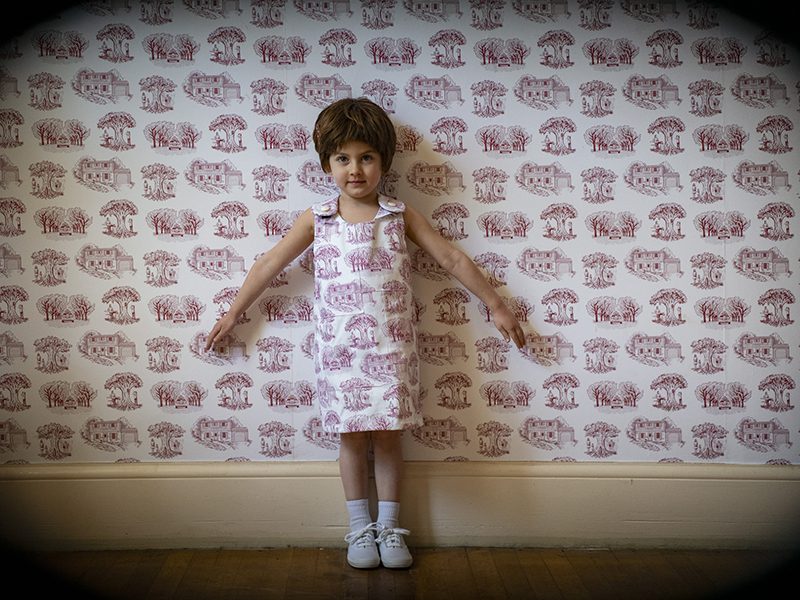
The Bowdoin College Museum of Art announced that photographer Jona Frank is working with the designer Alex Kalman to create an immersive environment evoking her suburban childhood in Cherry Hill, New Jersey, for the forthcoming exhibition “Jona Frank: Model Home.”
On view from Feb. 24 through June 5, the exhibition will be accompanied by a new publication of the same title. The exhibition reflects the artist’s youthful journey to find herself while attempting to grasp and failing to conform to the social mythologies encapsulated by the post-World War II suburban dwelling of her upbringing. Through photographs as well as various replicas of spaces and objects, Frank identifies with her childhood. “Jona Frank: Model Home” will invite viewers to experience episodes — both real and imagined — from Frank’s upbringing and, in so doing, to explore the promises and perils of suburbia conceived not so much as a material landscape as a state of mind.
Frank, who was born and raised in Cherry Hill, New Jersey, and now lives outside Los Angeles, California, has long explored through her photography the strategies of identity exploration and formation used by adolescents and young adults, often spending significant periods of time immersed in the world of her subjects. This characterized her approach to picturing the students populating the many cliques visible on American campuses in High School (2004); the conservative college students pictured in Right: Portraits from the Evangelical Ivy League (2008) and the young British boxers featured in The Modern Kids (2015).
In 2016, Frank turned her attention to her own youth, exploring the power — and also the limitations — of photography as a narrative tool in her 2020 visual memoir, “Cherry Hill: A Childhood Reimagined” (Monacelli Press), which was also designed by Alex Kalman. Pioneering the use of an anamorphic lens used in filmmaking to create the stills featured in her memoir and now in “Model Home,” Frank undermines the notion that a single, heroic image can encapsulate an entire narrative.
Through the immersive installation of “Model Home,” Frank plays with photography’s very limits and mythologies, extrapolating from it to create a broader framework replete with words and objects that transport the audience into the physical and psychic environment she pictures.
“Jona Frank: Model Home” picks up on themes explored in “Cherry Hill: A Childhood Reimagined,” including the alluring promise of the nuclear family that conforms itself to the demands of school and church, the deadening simulacra that populate “readymade” homes understood as the culmination of personal desire, and the claustrophobia created by heteronormative, patriarchal models. While using the language of photography, the artist simultaneously acknowledges and subverts the suburban rituals with which it is associated. Tacitly pointing to the common tendency to “perform” a particular role for the camera, Frank’s self-investigation does not directly picture the photographer and her family, but instead uses surrogates: actor Laura Dern portrays her mother while younger actors depict a maturing Frank. Forbidden as a child from handling the family camera (an experience “documented” by Frank), the artist plays with the residue of memory filtered through snapshots. In this assemblage of unsettling “Kodak moments,” pictures brandish moments of aggressive suburban pride: an expectant young mother places her hand over her abdomen with a knowing smile; mother and daughter in matching outfits show off “picture-perfect” pies.
Such photographs will be interlaced into an environment replete with toile wallpaper that playfully echoes “decisive moments” in the life of the photographer, while simultaneously threatening to engulf her. Also present is the rotary dial phone that seemed to bring only life-shattering pronouncements and a meticulous recreation of a birthday party gone awry. Colorful embroideries both reference the handiwork traditionally associated with “woman’s work” and humorously elevate the seemingly mundane to objects worthy of real attention. Transparent sculptures of the artist, filled with suggestive artifacts such as cherry blossoms and “lucky charms,” evoke the “Visible Man” educational toy that intrigued her as a child, while simultaneously raising questions about the qualities that enable others to “see” us or that seem to make us “invisible” to others. At the center of the exhibition stands a miniature sculptural facsimile of the artist’s childhood home, through which viewers can watch projections of the domestic tableaux unfolding within. The exhibition serves as a counterpoint to the photographs it features, bringing the viewer back into contact with the physical environment that so powerfully imprinted the mind of the artist as a young girl.
“From the very beginning of this project, I have been interested in playing with the structures of storytelling,” said Jona Frank. “In addition to using photography to explore the feelings and tensions I felt as a child, this project has also been about translating the sensations of childhood into a narrative experience. ‘Model Home’ has provided the opportunity to bring my photography to life through an experiential installation that enables viewers to enter the world I encountered in Cherry Hill and, hopefully, to find some elements of their own childhood experience within it.”
“During a historic moment when we are pluming questions about the formation of national and personal identities, Jona Frank’s work has remarkable resonance,” reflects Anne Collins Goodyear, co-director of the BCMA who oversaw the development of the exhibition. “With a disarming and even mischievous sense of humor, Frank invites her viewers to reflect on the intersection between the environments that shape us and the ideals they marshal. She asks how we achieve that particular alignment between youthful dreams and mature accomplishment that enables us to feel that we have somehow become ourselves, and challenges us to consider: ‘what else?’ Whether for students contemplating the steps they will take after completing school, or for those of us who have settled into careers and familiar habits, what more powerful — or important — provocation can art offer to its audience?”
The exhibition will be accompanied by the eponymous “Jona Frank: Model Home,” a new publication featuring essays by Jona Frank, Anne Collins Goodyear, photography critic Arthur Lubow, writer Hanna Rosin, curator Dorothy Moss, journalist Jori Finkel and cultural historian and essayist D.J. Waldie and an interview between the artist and actor Laura Dern.
Bowdoin College Museum of Art is at 245 Maine St., Brunswick. Call 207-725-3275, or go to https://www.bowdoin.edu/art-museum for more information.

